|
|
|
Sort Order |
|
|
|
Items / Page
|
|
|
|
|
|
|
| Srl | Item |
| 1 |
ID:
095936
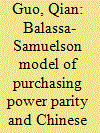

|
|
|
|
|
| Publication |
2010.
|
| Summary/Abstract |
Our principal purpose here is to assess the extent to which both the official and black market exchange rates for the Chinese economy exhibit compatibility with the Balassa-Samuelson model over the period from 1985 to 2006. We employ annual measures of inflation and industry input on an aggregated, disaggregated and sector basis, all of which have been especially constructed for this study. Both the time series and panel cointegration tests applied to this data are generally inconsistent with the prediction of the Balassa-Samuelson model that the tradable goods sector is compatible with purchasing power parity. However, our analysis also shows that other predictions of the Balassa-Samuelson model - most notably that there will be a strong long-run relationship between the real exchange rate and the relative productivity differential between China and the U.S. - does hold up for the Chinese economy. Moreover, the black market exchange rate appears to be more consistent with the predictions of the Balassa-Samuelson model than the official exchange rate.
|
|
|
|
|
|
|
|
|
|
|
|
|
|
|
|
| 2 |
ID:
072629
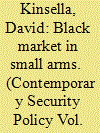

|
|
|
|
|
| Publication |
2006.
|
| Summary/Abstract |
In recent years, researchers have increasingly turned their attention to the proliferation of small arms, a transnational trade amounting to over $7 billion in value during 2002. Small arms are difficult to track and are not the stuff of military parades, but they are immensely destructive. As much as $1 billion worth enters the black market annually. I argue that the illicit trade in small arms should be understood not as a market but as a network, one that shares some important properties with networked forms of organization studied by sociologists. I then employ quantitative methods developed for the study of social networks in an effort to show the basic structure of illegal small arms transfers to Africa. The analysis draws from my Illicit Arms Transfers dataset still in development, so the results make use of the most rudimentary information being collected. They are suggestive, however, and the analytical approach promises to shed considerable light on a corner of the global arms trade that is of great interest to the research and activist communities, and of great consequence to those in war-torn regions of the world.
|
|
|
|
|
|
|
|
|
|
|
|
|
|
|
|
| 3 |
ID:
080640
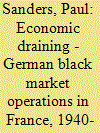

|
|
|
|
|
| Publication |
2008.
|
| Summary/Abstract |
Study of the black market is vital to understanding the social, economic and political stakes of the occupation in the Second World War. It allows a re-examination of German occupation policy, but also highlights civilian survival strategies, wealth distribution and the changing occupier - occupied relationship. In France, the German occupiers spent at least 15% of all financial resources made available to them through the Vichy occupation levy on the illegal market. This purchasing started from the onset of occupation and until the December 1941 resource crisis; German economic agencies bought 'anything, at any price'. This uncoordinated bidding led to a black market bubble, the effects of which spilled over into the official markets where they caused havoc. Spring 1942 brought the centralisation of purchasing. During the ensuing second phase (until spring 1943), the occupier still bought 'anything', but no longer at 'any price'. Although this stabilised prices, it also encouraged illegal production, with raw materials diverted from official industry allocations. During this period 50-60% of all Vichy occupation payments were spent on the black market, at a strategic juncture of the war when such extravagance was no longer justifiable. This undermined German finances in France and became a liability to exploitation and collaboration. The third phase of black market exploitation, from summer 1943 to the end of the occupation, was the most rational. The Germans restricted purchasing to genuinely indispensable strategic raw materials. This built on the effective implementation of a German black market purchasing ban in spring 1943, the support of the Vichy government and French industrial leaders for economic collaboration, business concentrations and closures, market monitoring and resource management methods. As a result, the illegal market in the industrial economy was largely controlled. Arguably the same degree of economic mobilisation could have been achieved one or even two years earlier, had the Germans abstained from unilateral black market purchasing and instead heeded Vichy calls for closer cooperation. German failure in this area was due to lack of coordination, institutional chaos, economic dilettantism, endemic corruption and reckless resource competition; all have their origin in the structure of the Nazi system. Illegal food markets, on the other hand, demonstrated the limits of coercion. As the nutritional value of official civilian rations remained below subsistence level, the French continued to depend on the illegal market for sustenance. Evading food restrictions became something of a national pastime. This further compounded Vichy's lack of willingness (and authority) in enforcing economic regulation in the countryside.
|
|
|
|
|
|
|
|
|
|
|
|
|
|
|
|
| 4 |
ID:
157474


|
|
|
|
|
| Summary/Abstract |
Terrorists could acquire nuclear weapons by using weapon-usable nuclear material that was stolen or otherwise diverted from legitimate authorities. Multiple well-documented seizures suggest the existence of a black market that draws on an unknown stock of weapon-usable nuclear material that is not under the control of authorities. We estimate the total amount of uncontrolled material based on publicly reported seizures and several different statistical methods and models. We estimate that 90 to 250 kilograms--sufficient for up to ten nuclear weapons--remain outside the control of legitimate authorities. While this estimate is subject to large uncertainties and potential bias, governments may have additional information about nuclear material seizures that could be used to improve estimates.
|
|
|
|
|
|
|
|
|
|
|
|
|
|
|
|
| 5 |
ID:
117969
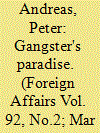

|
|
|
|
|
| Publication |
2013.
|
| Summary/Abstract |
The dark underside of the global economy is thriving. Globalization has been good not only for legitimate businesses but also for those who traffic in illegal drugs, evade sanctions or taxes, trade stolen goods and intellectual property on the black market, smuggle immigrants, and launder money. Some of these activities are merely policing headaches. But others pose major security challenges to governments around the world.
|
|
|
|
|
|
|
|
|
|
|
|
|
|
|
|
| 6 |
ID:
115300
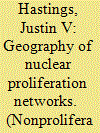

|
|
|
|
|
| Publication |
2012.
|
| Summary/Abstract |
This article uses a geographic approach to examine one aspect of the nuclear black market: the coordinators who bring buyers and sellers together, and transport goods between them. The most important factor in determining the geographical structure of a proliferation network is the network coordinator's access (or lack thereof) to unique state resources. Coordinators with access to state resources and prerogatives can avoid embedding themselves in hostile countries or relying on commercial infrastructure, often leading to territorially diffuse logistical networks. Coordinators without such access are forced to rely on commercial infrastructure and favorable local political, economic, and social conditions, often resulting in territorially centralized logistical networks. This is illustrated through case studies of Abdul Qadeer Khan's supply networks to Pakistan, Libya, and Iran. The article concludes with some observations about the implications of a geographical approach for understanding nuclear proliferation networks.
|
|
|
|
|
|
|
|
|
|
|
|
|
|
|
|
| 7 |
ID:
126024
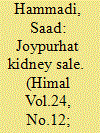

|
|
|
|
|
| Publication |
2011.
|
| Summary/Abstract |
Twenty-six-year-old Mizanur Rahman was desperately looking for a way to settle debts he had incurred while buying a small piece of land in Bagoil, a village in Joypurhat district in the north of Bangladesh. It had been three years, and the loan sharks who had lent him 10,000 taka (USD 130) three years ago were now asking for more than three times as much, some USD 418. Mizanur is a farmer with a two-year-old son and a wife to take care of, and he wanted to get rid of his debts so that his family would not have to deal with them. He heard that his neighbour had earned some quick cash by donating one of his kidneys - a man named Golam was brokering kidney transplant in his village. 'You will not even realise that you had a surgery,' he had told Mizanur. So, on 3 August, Mizanur went to a Dhaka hospital and gave away one of his kidneys; in return, he was paid USD 1830.
|
|
|
|
|
|
|
|
|
|
|
|
|
|
|
|
| 8 |
ID:
076715
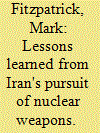

|
|
|
|
|
| Publication |
2006.
|
| Summary/Abstract |
Tipped off by Iran's efforts to acquire uranium enrichment and plutonium reprocessing technology, despite the economic illogic, the United States and its allies identified Tehran's nuclear weapons intentions early on and took effective action to stop several countries from inadvertently assisting that program. This postponed the worst-case scenario of when Iran might have the bomb, which for 15 years has been estimated at being five to ten years away. The intelligence success gave insufficient attention, however, to Iran's procurement efforts through non-state actors on the black market. Intelligence on Iran's motivations also will be important to devising effective policies. Those motivations include a need to achieve prestige, assert national pride, and secure dominance in the Gulf region. Iran's clerical leaders also see a nuclear capability as the best way to ensure their survival despite outside threats and internal opposition. At least 10 indicators of military involvement in the program have become known, reinforcing the judgment that Tehran is still intent on developing a latent nuclear weapons capability. Despite the confirmed evidence, the international community has not been able to change Iran's strategic calculations. The intelligence indicators will need to be corroborated if the world is to summon the will to put firm pressure on Iran to stop its nuclear pursuits.
|
|
|
|
|
|
|
|
|
|
|
|
|
|
|
|
| 9 |
ID:
159180


|
|
|
|
|
| Summary/Abstract |
In the 1990s, a part of the North Korean economy underwent a process of marketization and de facto privatization. While largely spontaneous, this process was eerily reminiscent of developments in other post-Communist countries in Eastern Europe. One of the results was the emergence of a new entrepreneurial class, a nascent bourgeoisie. In order to overcome the obstacles that arose from the lack of any legal framework for their activities, they often chose to register their enterprises with state agencies, creating what we call Pseudo-state Enterprises (PSEs). Utilizing an agency theory approach, with particular emphasis on property rights and contracting problems, this article traces the origin of the PSE, their interaction with the state, how they are managed and the challenges they face. The article is based on refugee interviews with five North Koreans involved with the PSE-related activities in nine entities covering a range of different sectors.
|
|
|
|
|
|
|
|
|
|
|
|
|
|
|
|
| 10 |
ID:
129304
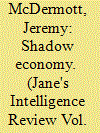

|
|
|
| 11 |
ID:
132438


|
|
|
|
|
|
|
|